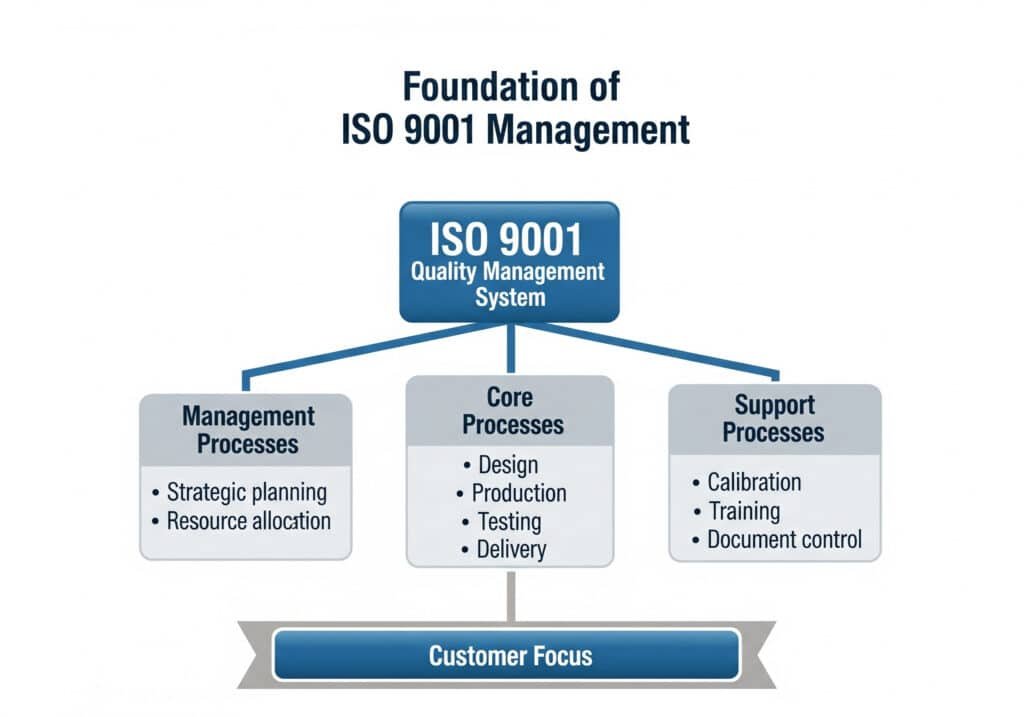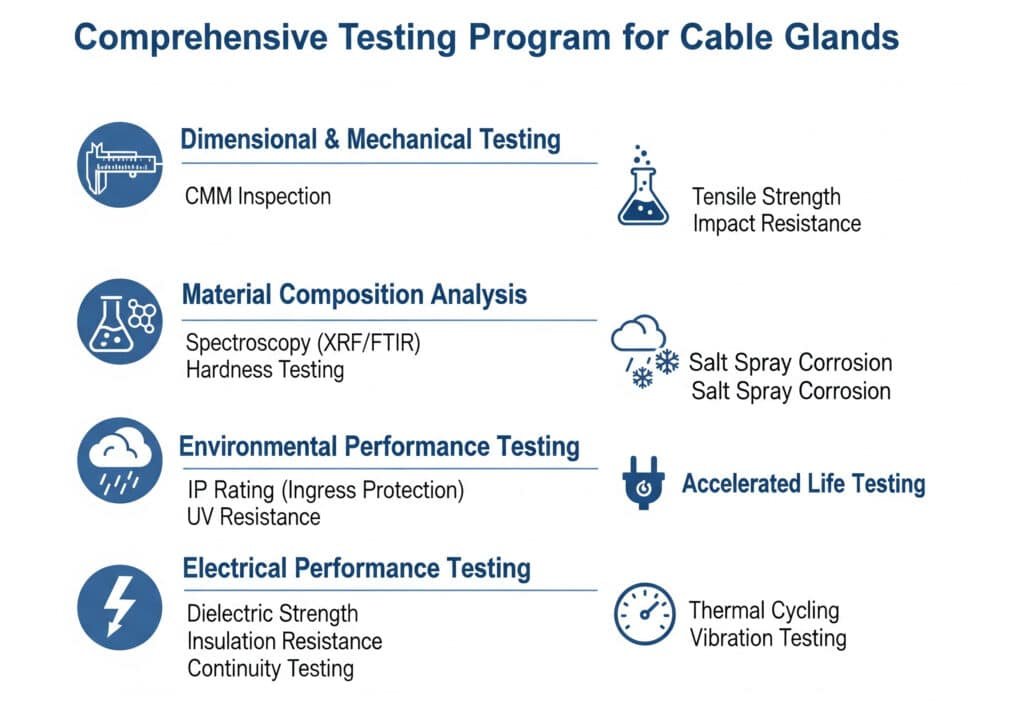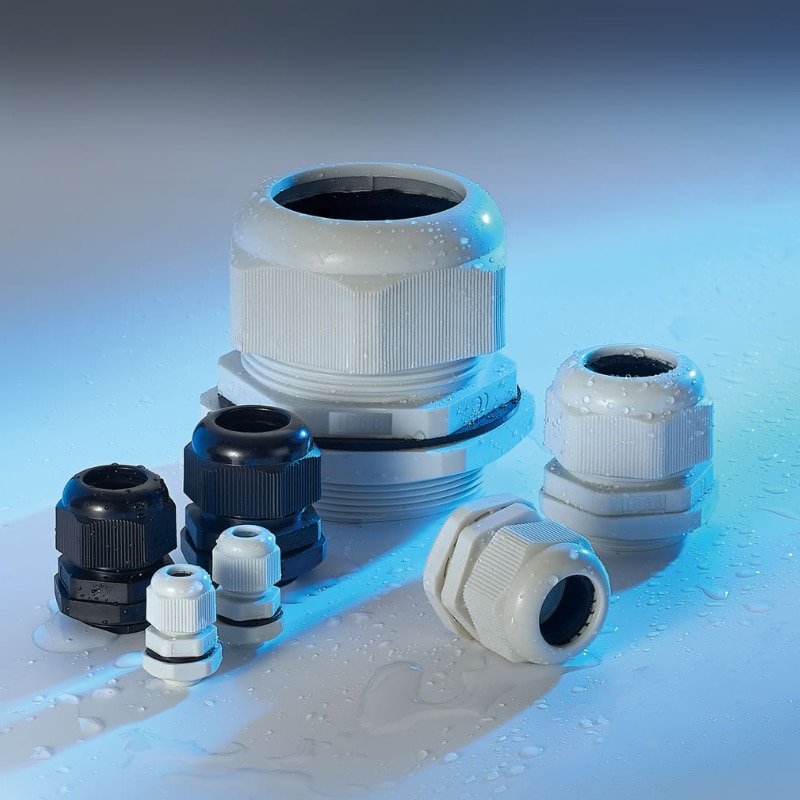Worried about cable gland quality failures in critical applications? One defective component can shut down your entire production line.
Our ISO 90011 certified manufacturing process ensures consistent cable gland quality through systematic quality control at every stage – from raw material inspection to final product testing, eliminating defects and guaranteeing reliable performance in your applications.
Yesterday, David, a procurement manager from a major automation company, called me frustrated after receiving a batch of “certified” cable glands that failed during installation. The supplier’s quality system was a facade – no real testing, no traceability, just paperwork. That’s exactly why we built our ISO 9001 system from the ground up. 😉
Table of Contents
- What Does ISO 9001 Certification Actually Mean for Cable Gland Manufacturing?
- How Do We Control Quality from Raw Materials to Finished Products?
- What Testing and Inspection Procedures Guarantee Consistent Performance?
- How Does Our Documentation System Ensure Traceability and Continuous Improvement?
What Does ISO 9001 Certification Actually Mean for Cable Gland Manufacturing?
Understanding ISO 9001 isn’t just about certificates on the wall – it’s about having systems that actually work when your business depends on them.
ISO 9001 certification requires documented quality management systems, regular third-party audits, continuous improvement processes, and customer focus – ensuring every cable gland meets specifications consistently, not just occasionally.

The Foundation of ISO 9001 Quality Management
Process-Based Approach:
At Bepto, we don’t just manufacture cable glands – we manage interconnected processes that deliver consistent results. Every step from design to delivery follows documented procedures with clear inputs, outputs, and controls.
Key Process Categories:
- Management Processes: Strategic planning, resource allocation, management review
- Core Processes: Design, procurement, production, testing, delivery
- Support Processes: Calibration, training, document control, internal audits
Customer Focus Principle:
ISO 9001 requires us to understand and meet customer requirements consistently. This means:
- Regular customer satisfaction surveys and feedback analysis
- Clear communication channels for requirements and changes
- Proactive identification of customer needs and expectations
- Systematic handling of customer complaints and corrective actions
Real ISO 9001 vs. Paper Certificates
David’s Bad Experience:
His previous supplier claimed ISO 9001 certification but had:
- No documented procedures for critical processes
- Missing calibration records for measuring equipment
- No traceability system for raw materials
- Inadequate testing and inspection procedures
- No systematic approach to corrective actions
Our Genuine Implementation:
- Living Documentation: Procedures are actually followed, not just filed
- Regular Audits: Both internal and external audits verify compliance
- Measurable Objectives: Quality targets with regular monitoring
- Employee Training: All staff understand their role in quality
- Continuous Improvement: Regular system updates based on data
ISO 9001:2015 Key Requirements for Manufacturing
Context of the Organization:
We analyze internal and external factors affecting our ability to deliver quality cable glands:
- Market trends and customer expectations
- Regulatory requirements and standards
- Technology developments and innovations
- Supplier capabilities and risks
- Internal resources and competencies
Leadership and Commitment:
Management demonstrates leadership by:
- Establishing quality policy and objectives
- Ensuring customer focus throughout organization
- Providing necessary resources for quality system
- Promoting awareness and engagement
- Supporting continuous improvement initiatives
Risk-Based Thinking2:
We identify and address risks that could affect product quality:
- Supplier quality risks and mitigation strategies
- Equipment failure prevention and maintenance
- Environmental factors affecting production
- Human resource risks and training needs
- Market and customer requirement changes
Quality Management System Structure
Document Hierarchy:
- Quality Manual: Overall system description and policy
- Procedures: Step-by-step process instructions
- Work Instructions: Detailed task-specific guidance
- Forms and Records: Evidence of system implementation
Process Integration:
Our quality management system integrates with:
- IATF 169493: Automotive industry specific requirements
- Environmental Management: ISO 14001 principles
- Occupational Health & Safety: Risk prevention measures
- Information Security: Data protection and confidentiality
Certification and Surveillance Process
Initial Certification:
- Stage 1 audit: Documentation review and readiness assessment
- Stage 2 audit: On-site implementation verification
- Certification decision based on conformity evidence
- Certificate issuance with defined scope and validity
Ongoing Surveillance:
- Annual surveillance audits by certification body
- Continuous monitoring of system effectiveness
- Management review meetings for system evaluation
- Corrective action implementation and verification
At Bepto, our ISO 9001 certification isn’t just a marketing tool – it’s the foundation of how we operate every day to ensure your cable glands meet specifications consistently.
How Do We Control Quality from Raw Materials to Finished Products?
Quality control isn’t just final inspection – it’s built into every step of our manufacturing process to prevent defects before they occur.
Our quality control system includes incoming material inspection, in-process monitoring, statistical process control4, and final product testing – ensuring defects are caught and corrected immediately rather than reaching customers.
Incoming Material Quality Control
Supplier Qualification Process:
Before any material enters our facility, suppliers must pass rigorous qualification:
Technical Assessment:
- Manufacturing capability evaluation
- Quality system audit and certification
- Sample testing and approval process
- Delivery performance and reliability
- Financial stability and business continuity
Material Specifications:
Every raw material has detailed specifications covering:
- Chemical composition and mechanical properties
- Dimensional tolerances and surface finish
- Certification requirements (material certificates)
- Packaging and handling requirements
- Traceability and identification needs
Incoming Inspection Procedures:
Brass Raw Materials:
- Chemical composition verification using spectrometer
- Dimensional inspection with calibrated measuring tools
- Surface quality assessment for defects
- Hardness testing for mechanical properties
- Certificate of compliance verification
Nylon and Polymer Materials:
- Material identification testing (FTIR spectroscopy)
- Moisture content measurement
- Color matching and consistency check
- Melt flow index testing for processing
- Environmental compliance verification (RoHS, REACH)
Stainless Steel Components:
- Grade verification through chemical analysis
- Corrosion resistance testing
- Mechanical property confirmation
- Surface finish quality assessment
- Magnetic permeability testing when required
In-Process Quality Control
Production Line Monitoring:
Injection Molding Process Control:
- Temperature monitoring at multiple zones
- Pressure and speed parameter verification
- Cycle time consistency tracking
- First article inspection for each setup
- Statistical process control (SPC) implementation
CNC Machining Quality Control:
- Tool wear monitoring and replacement
- Dimensional verification during production
- Surface finish measurement
- Geometric tolerance verification
- In-process capability studies
Assembly Process Control:
- Component fit and function verification
- Torque specification compliance
- Seal integrity testing
- Visual inspection for defects
- Functionality testing before packaging
Statistical Process Control Implementation
Control Chart Management:
We use control charts to monitor critical parameters:
- X-bar and R charts for dimensional control
- P-charts for defect rate monitoring
- C-charts for defect count tracking
- Process capability studies (Cp, Cpk)
- Trend analysis and corrective action triggers
Hassan’s Chemical Plant Requirements:
When Hassan needed explosion-proof cable glands for his refinery, our SPC data showed:
- Process capability index (Cpk) of 1.67 for critical dimensions
- Zero defects in thread specifications over 6 months
- Consistent material properties within ±2% variation
- 99.8% first-pass yield rate
- Complete traceability for every component
Process Validation and Control
Equipment Calibration:
All measuring and testing equipment undergoes regular calibration:
- Measurement uncertainty analysis
- Traceability to national standards
- Calibration interval determination
- Out-of-tolerance investigation procedures
- Calibration record maintenance
Environmental Controls:
Manufacturing environment affects product quality:
- Temperature and humidity monitoring
- Clean room standards for sensitive operations
- Contamination prevention procedures
- Static electricity control measures
- Proper material storage conditions
Continuous Improvement Integration
Data-Driven Decisions:
Our quality control generates data for improvement:
- Defect analysis and root cause investigation
- Process optimization opportunities
- Supplier performance evaluation
- Customer feedback integration
- Cost of quality measurement
Corrective and Preventive Actions:
When issues arise, we implement systematic solutions:
- Problem identification and containment
- Root cause analysis using structured methods
- Corrective action implementation and verification
- Preventive measures to avoid recurrence
- System updates and training as needed
At Bepto, quality control isn’t an afterthought – it’s integrated into every step of our manufacturing process, ensuring the cable glands you receive meet your specifications every single time.
What Testing and Inspection Procedures Guarantee Consistent Performance?
Testing isn’t just about meeting specifications – it’s about ensuring your cable glands perform reliably in real-world conditions.
Our comprehensive testing program includes dimensional verification, material property testing, environmental simulation, performance validation, and accelerated life testing – providing confidence that every cable gland will perform as expected in your application.

Dimensional and Mechanical Testing
Precision Measurement Systems:
Coordinate Measuring Machine (CMM) Inspection:
- Three-dimensional accuracy verification
- Geometric tolerance measurement (GD&T)
- Thread profile and pitch verification
- Surface profile analysis
- Statistical dimension reporting
Thread Testing Procedures:
Critical for cable gland functionality:
- Go/No-Go gauge verification
- Thread pitch accuracy measurement
- Thread engagement length verification
- Torque-tension relationship testing
- Thread coating thickness measurement
Mechanical Property Testing:
Tensile Strength Verification:
- Ultimate tensile strength measurement
- Yield strength determination
- Elongation and reduction of area
- Stress-strain curve analysis
- Material certificate correlation
Impact and Fatigue Testing:
- Charpy impact test for toughness
- Fatigue life under cyclic loading
- Vibration resistance testing
- Thermal shock resistance
- Long-term creep behavior
Material Composition Analysis
Chemical Analysis Methods:
Spectroscopic Analysis:
- X-ray fluorescence (XRF) for elemental composition
- Optical emission spectroscopy for metals
- Infrared spectroscopy (FTIR) for polymers
- Mass spectrometry for trace elements
- Wet chemical analysis for verification
Polymer Testing:
- Melt flow index for processing consistency
- Density measurement for material verification
- Thermal analysis (DSC, TGA) for stability
- UV resistance testing for outdoor applications
- Chemical resistance evaluation
Environmental Performance Testing
IP Rating Verification:
Water Ingress Testing:
Following IEC 60529 standards:
- IPX4: Splashing water from any direction
- IPX6: Powerful jets of water
- IPX7: Temporary immersion in water
- IPX8: Continuous submersion
- IPX9K: High-pressure, high-temperature washdown
Dust Protection Testing:
- IP5X: Dust protected (limited ingress)
- IP6X: Dust tight (no ingress)
- Test chamber with talcum powder
- Vacuum application for ingress verification
- Visual inspection after exposure
Temperature Cycling Tests:
Thermal Performance Validation:
- High-temperature exposure testing
- Low-temperature brittleness evaluation
- Thermal cycling endurance
- Coefficient of thermal expansion measurement
- Seal integrity under temperature variation
Electrical Performance Testing
Insulation Resistance Testing:
- High-voltage insulation verification
- Dielectric strength measurement
- Insulation resistance over time
- Temperature coefficient of resistance
- Humidity effect on insulation
Grounding Continuity Verification:
- Low-resistance measurement
- Four-wire resistance testing
- Contact resistance stability
- Corrosion effect on conductivity
- Long-term resistance monitoring
Accelerated Life Testing
Reliability Prediction:
Accelerated Aging Tests:
- Elevated temperature aging
- UV exposure simulation
- Ozone resistance testing
- Chemical exposure evaluation
- Mechanical stress acceleration
Life Prediction Models:
- Arrhenius equation for temperature effects
- Eyring model for multiple stress factors
- Weibull analysis for failure distribution
- Mean time to failure (MTTF) calculation
- Confidence interval determination
Quality Control Documentation
Test Report Generation:
Comprehensive Test Records:
Every cable gland batch includes:
- Complete dimensional inspection report
- Material composition certificate
- Environmental test results
- Electrical performance data
- Accelerated life test summary
Traceability Documentation:
- Raw material lot numbers
- Manufacturing date and batch codes
- Test equipment calibration status
- Inspector identification and qualification
- Customer-specific test requirements
Customer-Specific Testing
David’s Automation Requirements:
For his control panel applications, we provided:
- Vibration testing per IEC 60068-2-6
- EMC shielding effectiveness measurement
- Temperature cycling from -40°C to +100°C
- Salt spray corrosion testing (500 hours)
- Pull-out strength verification (500N minimum)
Hassan’s Explosion-Proof Testing:
For his chemical plant applications:
- ATEX certification testing
- Flame path dimension verification
- Maximum surface temperature measurement
- Impact testing per IEC 60079-1
- Ingress protection IP66/IP68 verification
Quality Assurance Integration
Statistical Quality Control:
- Acceptance sampling plans (AQL standards)
- Process capability monitoring
- Control chart maintenance
- Trend analysis and prediction
- Customer satisfaction correlation
Continuous Improvement:
- Test method validation and improvement
- Equipment upgrade and modernization
- Staff training and certification
- Customer feedback integration
- Industry standard updates
At Bepto, our testing procedures go beyond basic compliance – we validate performance under real-world conditions to ensure your cable glands deliver reliable service throughout their intended life.
How Does Our Documentation System Ensure Traceability and Continuous Improvement?
Documentation isn’t just paperwork – it’s the foundation that enables us to track every product, identify improvement opportunities, and respond quickly to any issues.
Our integrated documentation system provides complete traceability from raw materials to customer delivery, enables rapid root cause analysis, facilitates continuous improvement, and ensures regulatory compliance through systematic record keeping and data analysis.
Comprehensive Traceability System
Raw Material Tracking:
Material Identification System:
Every raw material batch receives unique identification:
- Supplier lot numbers and certificates
- Incoming inspection results and dates
- Storage location and handling records
- Usage tracking in production batches
- Remaining inventory and expiration dates
Digital Material Database:
- Chemical composition records
- Mechanical property test results
- Supplier performance history
- Cost and delivery tracking
- Quality trend analysis
Production Batch Documentation:
Manufacturing Records:
Each production batch maintains complete records:
- Work order specifications and revisions
- Machine setup parameters and verification
- Operator identification and qualifications
- In-process inspection results
- Environmental conditions during production
Process Control Documentation:
- Statistical process control charts
- Equipment calibration status
- Tool change and maintenance records
- Quality control checkpoints
- Non-conformance reports and corrections
Digital Quality Management System
Integrated Software Platform:
Real-Time Data Collection:
Our quality management system captures:
- Automatic data from production equipment
- Manual inspection results entry
- Test equipment direct data transfer
- Barcode scanning for identification
- Time-stamped activity logging
Database Integration:
- ERP system connectivity for order tracking
- Laboratory information management (LIMS)
- Customer relationship management (CRM)
- Supplier quality management
- Document control and revision management
Customer-Specific Documentation
Customized Reporting:
David’s Documentation Requirements:
For his automation projects, we provide:
- Certificate of compliance with specifications
- Dimensional inspection reports with actual measurements
- Material certificates with chemical composition
- Test results for environmental performance
- Traceability records linking materials to finished products
Hassan’s Regulatory Documentation:
For his chemical plant applications:
- ATEX certification documents and test reports
- Material safety data sheets (MSDS)
- Welding procedure specifications (WPS)
- Non-destructive testing (NDT) records
- Pressure vessel code compliance documentation
Change Control and Configuration Management
Engineering Change Control:
Systematic Change Process:
All product changes follow documented procedures:
- Change request evaluation and approval
- Impact assessment on existing products
- Customer notification and approval process
- Implementation verification and validation
- Updated documentation and training
Version Control:
- Drawing revision management
- Specification change tracking
- Process procedure updates
- Training material revisions
- Customer communication records
Corrective and Preventive Action System
CAPA Implementation:
Problem Identification:
- Customer complaint analysis
- Internal audit findings
- Supplier quality issues
- Production non-conformances
- Management review observations
Root Cause Analysis:
- Fishbone diagram analysis
- 5-Why investigation technique
- Statistical correlation analysis
- Process capability studies
- Failure mode and effects analysis5 (FMEA)
Action Implementation and Verification:
- Corrective action planning and scheduling
- Resource allocation and responsibility assignment
- Implementation monitoring and verification
- Effectiveness evaluation and measurement
- System updates and preventive measures
Continuous Improvement Documentation
Performance Metrics:
Key Performance Indicators (KPIs):
We track and document:
- First-pass yield rates by product line
- Customer satisfaction scores and trends
- Supplier quality performance ratings
- On-time delivery performance
- Cost of quality measurements
Improvement Project Documentation:
- Project charter and objectives
- Baseline measurement and targets
- Implementation timeline and milestones
- Resource requirements and allocation
- Results measurement and validation
Regulatory Compliance Records
Certification Maintenance:
ISO 9001 Documentation:
- Quality manual and procedures
- Internal audit reports and findings
- Management review meeting minutes
- Training records and competency verification
- Customer satisfaction surveys and analysis
Industry-Specific Requirements:
- IATF 16949 automotive quality records
- ATEX explosion-proof certification documentation
- CE marking technical files
- RoHS and REACH compliance records
- Environmental management system documentation
Data Security and Backup
Information Protection:
Access Control:
- User authentication and authorization
- Role-based access permissions
- Data encryption and security protocols
- Audit trails for system access
- Regular security assessments
Backup and Recovery:
- Automated daily data backups
- Off-site storage and cloud backup
- Disaster recovery procedures
- Data integrity verification
- Business continuity planning
Customer Access and Transparency
Portal Services:
Real-Time Information Access:
Customers can access:
- Order status and production progress
- Quality test results and certificates
- Delivery tracking and confirmation
- Technical documentation and drawings
- Historical performance data
Collaborative Communication:
- Secure messaging and file sharing
- Technical support ticket system
- Change request submission and tracking
- Feedback and suggestion collection
- Performance review meetings
Return on Investment
Documentation System Benefits:
Quantifiable Improvements:
- 95% reduction in customer complaint resolution time
- 80% decrease in non-conformance investigation time
- 90% improvement in supplier quality performance
- 75% reduction in regulatory audit preparation time
- 85% increase in customer satisfaction scores
Cost Savings:
- Reduced warranty claims and returns
- Faster problem resolution and correction
- Improved supplier relationships and pricing
- Enhanced customer loyalty and retention
- Streamlined regulatory compliance costs
At Bepto, our documentation system isn’t just about keeping records – it’s about creating transparency, enabling improvement, and building the trust that long-term partnerships require.
Conclusion
Our ISO 9001 certified process transforms quality from hope to certainty – systematic controls, comprehensive testing, and complete documentation ensure your cable glands perform reliably every time.
FAQs About ISO 9001 Certified Cable Gland Manufacturing
Q: What’s the difference between ISO 9001 certification and just having quality procedures?
A: ISO 9001 certification requires third-party audits, documented procedures that are actually followed, measurable quality objectives, and continuous improvement. Many companies have quality procedures on paper, but ISO 9001 ensures they’re implemented and effective in practice.
Q: How does your ISO 9001 system prevent defective cable glands from reaching customers?
A: Our system includes incoming material inspection, in-process monitoring, statistical process control, and final product testing. Each step has documented procedures with clear pass/fail criteria, ensuring defects are caught and corrected before products ship.
Q: Can you provide complete traceability for cable glands used in critical applications?
A: Yes, our documentation system tracks every cable gland from raw material lot numbers through production batches to customer delivery. We can provide complete material certificates, test results, and manufacturing records for any product within minutes.
Q: How often is your ISO 9001 certification audited and verified?
A: Our ISO 9001 certification is audited annually by an accredited third-party certification body, plus we conduct internal audits quarterly. We also have management review meetings monthly to ensure continuous system effectiveness and improvement.
Q: What happens if a quality issue is discovered after delivery?
A: Our CAPA (Corrective and Preventive Action) system immediately investigates root causes, implements corrections, and prevents recurrence. Complete traceability allows us to quickly identify affected products and customers, enabling rapid response and resolution.
-
Review the official standard for quality management systems from the International Organization for Standardization. ↩
-
Understand how this core principle of ISO 9001 helps organizations proactively identify and mitigate quality risks. ↩
-
Explore the global quality management standard specifically designed for the automotive industry supply chain. ↩
-
Learn the fundamentals of SPC, a powerful method for monitoring and controlling process quality using statistical data. ↩
-
Discover the step-by-step process of FMEA, a structured tool for analyzing and preventing potential process failures. ↩



